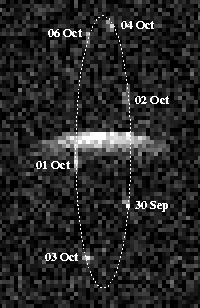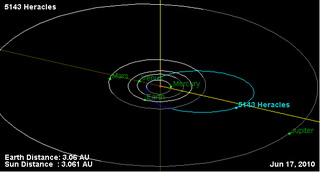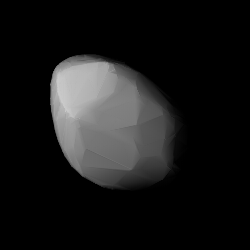
1620 Geographos is a highly elongated, stony asteroid, near-Earth object and potentially hazardous asteroid of the Apollo group, with a mean-diameter of approximately 2.5 km (1.6 mi). It was discovered on 14 September 1951, by astronomers Albert George Wilson and Rudolph Minkowski at the Palomar Observatory in California, United States. The asteroid was named in honor of the National Geographic Society.
2063 Bacchus, provisional designation 1977 HB, is a stony asteroid and near-Earth object of the Apollo group, approximately 1 kilometer in diameter. The contact binary was discovered on 24 April 1977, by American astronomer Charles Kowal at the Palomar Observatory in California, United States. It was named after Bacchus from Roman mythology.

1627 Ivar is an elongated stony asteroid and near-Earth object of the Amor group, approximately 15×6×6 km. It was discovered on 25 September 1929, by Danish astronomer Ejnar Hertzsprung at Leiden Southern Station, annex to the Johannesburg Observatory in South Africa. It was named after Ivar Hertzsprung, brother of the discoverer. 1627 Ivar was the first asteroid to be imaged by radar, in July 1985 by the Arecibo Observatory.
2797 Teucer is a large Jupiter trojan from the Greek camp, approximately 110 kilometers in diameter. It was discovered on 4 June 1981, by American astronomer Edward Bowell at the Anderson Mesa Station near Flagstaff, Arizona, in the United States. The dark D-type asteroid belongs to the 20 largest Jupiter trojans and has a rotation period of 10.15 hours. It was named after the Greek hero and great archer, Teucer.
3709 Polypoites is a large Jupiter trojan from the Greek camp, approximately 85 kilometers in diameter. The Trojan asteroid was discovered on 14 October 1985, by American astronomer Carolyn Shoemaker at the Palomar Observatory in California, United States, and named after Polypoites from Greek mythology. The dark D-type asteroid belongs to the 50 largest Jupiter trojans. It has a rotation period of 10 hours and possibly a spherical shape.

(185851) 2000 DP107 is a sub-kilometer sized asteroid, classified as potentially hazardous asteroid and near-Earth object of the Apollo group that is notable because it provided evidence for binary asteroids in the near-Earth population. The PROCYON probe developed by JAXA and the University of Tokyo was intended to flyby this asteroid before its ion thruster failed and could not be restarted.
5806 Archieroy, provisional designation 1986 AG1, is a stony Hungaria asteroid from the inner regions of the asteroid belt, approximately 6 kilometers in diameter. It was discovered on 11 January 1986, by American astronomer Edward Bowell at Lowell's Anderson Mesa Station near Flagstaff, Arizona. It is named after Scottish astrophysicist Archie Roy.

1580 Betulia, provisional designation 1950 KA, is an eccentric, carbonaceous asteroid, classified as near-Earth object of the Amor group, approximately 4.2 kilometers in diameter. It was discovered on 22 May 1950, by South African astronomer Ernest Johnson at the Union Observatory in Johannesburg. The asteroid was named for Betulia Toro, wife of astronomer Samuel Herrick.
2363 Cebriones is a large Jupiter trojan from the Trojan camp, approximately 84 kilometers in diameter. It was discovered on 4 October 1977, by astronomers at the Purple Mountain Observatory in Nanking, China. The dark D-type asteroid is one of the 40 largest Jupiter trojans and has a rotation period of 20 hours. It was named after Cebriones, Hektor's charioteer from Greek mythology.
4063 Euforbo is a large Jupiter trojan from the Greek camp, approximately 100 kilometers in diameter. It was discovered on 1 February 1989, by Italian astronomers at the San Vittore Observatory near Bologna, Italy. The dark D-type asteroid is one of the 25 largest Jupiter trojans and has a rotation period of 8.8 hours. It was named after Euphorbus (Euforbo) from Greek mythology.

5143 Heracles(provisional designation 1991 VL) is a highly eccentric, rare-type asteroid and synchronous binary system, classified as near-Earth object of the Apollo group, approximately 4.8 kilometers in diameter. The asteroid was discovered on 7 November 1991, by American astronomer Carolyn Shoemaker at Palomar Observatory in California, United States. It is named for the Greek divine hero Heracles. It has an Earth minimum orbit intersection distance of 0.058 AU (8.7 million km) and is associated with the Beta Taurids daytime meteor shower.
3800 Karayusuf, provisional designation 1984 AB, is a Mars-crossing asteroid and suspected binary system from inside the asteroid belt, approximately 2.5 kilometers in diameter. It was discovered on 4 January 1984, by American astronomer Eleanor Helin at the Palomar Observatory in California. The S/L-type asteroid has a short rotation period of 2.2 hours. It was named after Syrian physician Alford Karayusuf, a friend of the discoverer.
3793 Leonteus is a large Jupiter trojan from the Greek camp, approximately 90 kilometers in diameter. It was discovered on 11 October 1985, by American astronomer couple Carolyn and Eugene Shoemaker at the Palomar Observatory in California, United States. The D-type Jovian asteroid belongs to the 30 largest Jupiter trojans and has a rotation period of 5.6 hours. It was named after the hero Leonteus from Greek mythology.
4055 Magellan, provisional designation 1985 DO2, is a brightasteroid and near-Earth object of the Amor group. It is approximately 2.5 kilometers in diameter, and its orbit is moderately eccentric. It was discovered on 24 February 1985, by American astronomer Eleanor Helin at Palomar Observatory in California, United States. It was later named for Portuguese explorer Ferdinand Magellan.
3873 Roddy, provisional designation 1984 WB, is a stony Hungarian asteroid, Mars-crosser and suspected binary system, from the innermost regions of the asteroid belt, approximately 7 kilometers in diameter. It was discovered on 21 November 1984, by American astronomer Carolyn Shoemaker at the Palomar Observatory in California, United States. It was named after American astrogeologist David Roddy.
(10115) 1992 SK, is a stony near-Earth object and potentially hazardous asteroid on an eccentric orbit. It belongs to the group of Apollo asteroids and measures approximately 1 kilometer in diameter. It was discovered by American astronomers Eleanor Helin and Jeff Alu at the Palomar Observatory in California on 24 September 1992.

161989 Cacus is a stony asteroid, classified as near-Earth object and a potentially hazardous asteroid of the Apollo group, approximately 1 kilometer in diameter. It was discovered on 8 February 1978, by German astronomer Hans-Emil Schuster at ESO's La Silla Observatory in northern Chile. Its orbit is confined between Venus and Mars.
(86039) 1999 NC43 (provisional designation 1999 NC43) is an asteroid on an eccentric orbit, classified as near-Earth object and potentially hazardous asteroid of the Apollo group, approximately 2 kilometers in diameter. This suspected tumbler and relatively slow rotator was discovered by LINEAR in 1999.
(16960) 1998 QS52 (provisional designation 1998 QS52) is a stony asteroid on a highly eccentric orbit, classified as near-Earth object and potentially hazardous asteroid of the Apollo group, approximately 4.1 kilometers (2.5 mi) in diameter. It was discovered on 25 August 1998, by astronomers of the LINEAR program at Lincoln Laboratory's Experimental Test Site near Socorro, New Mexico, in the United States. This asteroid is one of the largest potentially hazardous asteroid known to exist.
(143651) 2003 QO104, provisional designation 2003 QO104, is a stony asteroid, slow rotator and suspected tumbler on a highly eccentric orbit, classified as near-Earth object and potentially hazardous asteroid of the Amor and Apollo group, respectively. It was discovered on 31 August 2003, by astronomers of the Near-Earth Asteroid Tracking program at the Haleakala Observatory in Hawaii, United States. The Q-type asteroid has a rotation period of 114.4 hours and possibly an elongated shape. It measures approximately 2.3 kilometers (1.4 miles) in diameter and belongs the largest potentially hazardous asteroids known to exist.






